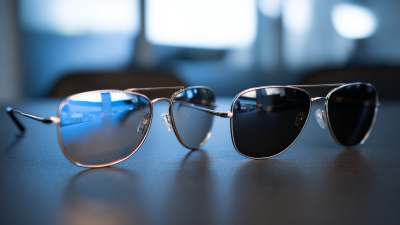Selecting the optimal sunglass lenses is crucial not only for enhancing your visual comfort but also for providing essential protection against harmful UV rays. According to the Vision Council’s 2022 Sunglasses Report, a staggering 42% of American adults do not wear sunglasses regularly, despite the fact that prolonged exposure to UV radiation can lead to serious ocular conditions, including cataracts and macular degeneration. As the demand for stylish yet functional eyewear continues to rise, understanding the various lens types available in 2025 will empower consumers to make informed decisions for their eye health and overall preservation of vision.

In recent years, advancements in lens technology have introduced a range of options that go beyond mere aesthetics. For instance, polarized lenses are designed to minimize glare from reflective surfaces, making them ideal for activities such as driving or engaging in water sports. Furthermore, photochromic lenses offer adaptability in diverse lighting conditions, transitioning from clear to tinted based on UV exposure. As per a recent market analysis from Grand View Research, the global sunglasses market is projected to reach $45 billion by 2025, indicating an increasing awareness of the importance of wearing quality sunglass lenses not just for fashion, but for proactive eye protection as well. Understanding these nuances will not only help consumers choose the best lens types but also significantly contribute to long-term ocular health.
When selecting the right lens material for your sunglasses, it’s crucial to prioritize both clarity and durability.
Polycarbonate lenses are a popular choice due to their lightweight nature and high impact resistance, making them ideal for sports and outdoor activities. Their natural UV protection also ensures that your eyes remain shielded from harmful rays while providing good clarity for visual tasks.
Another excellent option is polarized lenses, which not only reduce glare but also enhance visual comfort.
These lenses are typically made from either glass or polycarbonate, each offering distinct benefits.
Glass lenses provide superior optical clarity and scratch resistance but are heavier and less resistant to impacts.
On the other hand, polycarbonate polarized lenses combine the benefits of glare reduction with lightweight comfort, making them versatile for everyday wear.
Understanding these materials will help you choose sunglasses that offer both excellent vision quality and long-lasting protection.
When it comes to eye protection, understanding UV protection is crucial for maintaining ocular health, especially during the summer months when the sun’s rays are at their strongest. Research indicates that prolonged exposure to ultraviolet (UV) light can increase a person’s risk of developing serious eye conditions, including cataracts, macular degeneration, and even skin cancers around the eyes. The American Academy of Ophthalmology emphasizes that UV rays can also cause photokeratitis, a painful sunburn on the cornea, highlighting the need for protective eyewear.
Sunglasses are not merely a fashion statement; they are essential tools for safeguarding your eyes against harmful UV rays. Optometrists recommend sunglasses that offer 100% UV protection, which significantly reduces the risk of eye damage. In a recent study by the CDC, it was revealed that children are particularly vulnerable to UV exposure and may face long-term health issues if proper precautions are not taken. Therefore, selecting the right sunglasses, which include features like polarized lenses and wide frames, can provide both protection and comfort, allowing you to enjoy the outdoors without compromising your vision.
When selecting sunglass lenses, understanding the difference between polarized and non-polarized options is crucial for your specific needs. Polarized lenses contain a special filter that blocks intense reflected light, like the glare off water or roads. According to the American Academy of Ophthalmology, these lenses can significantly improve visibility and comfort, especially during outdoor activities such as fishing or skiing where glare is prevalent. They enhance contrast and reduce eye strain, making them an excellent choice for those who spend prolonged periods in bright environments.
On the other hand, non-polarized lenses are ideal for individuals who require a wider range of vision and depth perception. This type of lens does not alter color perception or affect how objects appear through the lens. It is suitable for activities like driving, where seeing LCD screens and distinguishing subtle color variations is important. The visibility alteration provided by polarized lenses can complicate these experiences.
Tips:
When selecting sunglass lenses, understanding lens color and tint is crucial for achieving clear vision and optimal eye comfort. Different colors serve specific purposes; for instance, gray lenses reduce overall brightness while preserving true color perception, making them ideal for everyday use. Brown and amber tints enhance contrast and depth perception, which can be beneficial for activities like driving or sports. According to the American Optometric Association, proper lens tint can mitigate glare and improve visual acuity, leading to a more comfortable experience for the wearer.
Tips for selecting lens colors include considering your typical outdoor activities. If you participate in water sports, blue or green lenses can provide better visibility on reflective surfaces. In contrast, yellow or gold lenses are advantageous in low-light or overcast conditions, as they enhance contrast and improve visibility. A study by the Vision Council indicates that 79% of individuals wear sunglasses primarily for protection against harmful UV rays; thus, choosing the right tint also contributes significantly to eye health.
Ultimately, the choice of lens color and tint impacts not just aesthetics but also functionality and comfort. To ensure maximum protection, look for lenses that block 100% of UVA and UVB rays while aligning color and tint with your lifestyle needs.
When selecting sunglass lenses, focusing on special features can significantly enhance both visual performance and protection. One critical element to consider is UV protection. According to the American Academy of Ophthalmology, prolonged exposure to UV rays can lead to various eye issues, including cataracts and macular degeneration. Look for lenses that offer 100% UV protection to ensure maximum safety for your eyes.
Another important feature is polarization. Polarized lenses reduce glare from reflective surfaces, making them ideal for outdoor activities such as driving or water sports. A study by the Vision Council states that polarized lenses can enhance visual clarity and comfort by blocking out intense light, allowing for a sharper and more defined view. Additionally, lens tint plays a role in performance; darker tints can reduce brightness while specialized tints, like amber or gray, can enhance contrast and depth perception in varying conditions. Choosing the right combination of these features not only improves visual quality but also provides ultimate protection from the sun's harmful effects.
| Lens Type | UV Protection | Polarization | Lens Material | Color Tint | Light Transmission |
|---|---|---|---|---|---|
| Polycarbonate | 99% UVA and UVB | Yes | Impact-resistant | Gray | 18% |
| CR-39 | 99% UVA and UVB | No | Optical quality | Brown | 15% |
| Glass | 99% UVA and UVB | Yes | Scratch-resistant | Green | 12% |
| Photochromic | 99% UVA and UVB | Optional | Varied | Variable | Varied |







